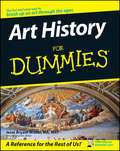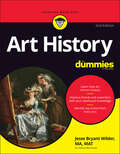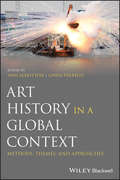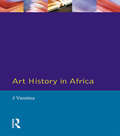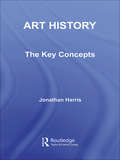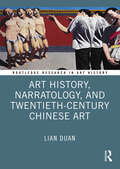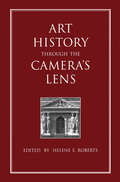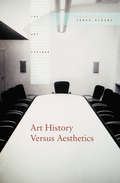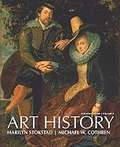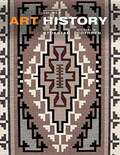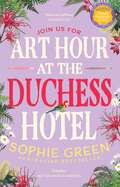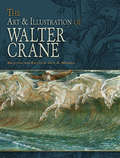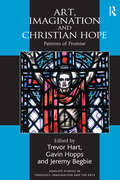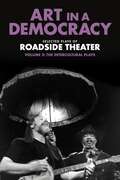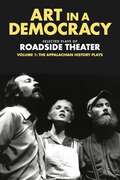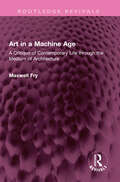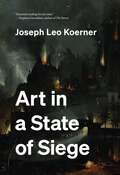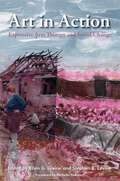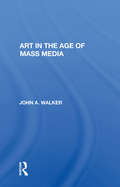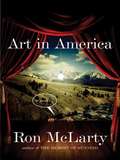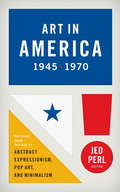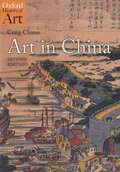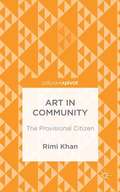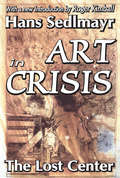- Table View
- List View
Art History For Dummies
by Jesse Bryant Wilder MA, MATArt history is more than just a collection of dates and foreign-sounding names, obscure movements and arcane isms. Every age, for the last 50,000 years has left its unique imprint on the world, and from the first cave paintings to the ceiling of the Sistine Chapel, from the Byzantine mosaics of the Hagia Sophia, to the graffiti-inspired paintings of Jean-Michel Basquiat, art history tells the story of our evolving notions of who and what we are and our place in the universe.Whether you're an art enthusiast who'd like to know more about the history behind your favorite works and artists, or somebody who couldn't tell a Titian and a De Kooning--but would like to--Art History For Dummies is for you. It takes you on a tour of thirty millennia of artistic expression, covering the artistic movements, major artists, and indispensable masterworks, and the world events and cultural trends that helped spawn them. With the help of stunning black-and-white photos throughout, and a sixteen-page gallery of color images, it covers:The rise and fall of classical art in Greece and RomeThe differences between Renaissance art and MannerismHow the industrial revolution spawned RomanticismHow and why Post-Impression branched off from ImpressionismConstructivism, Dadaism, Surrealism and other 20th century ismsWhat's up with today's eclectic art sceneArt History For Dummies is an unbeatable reference for anyone who wants to understand art in its historical context.
Art History For Dummies
by Jesse Bryant WilderReady to discover the fascinating world of art history? Let’s (Van) Gogh! Fine art might seem intimidating at first. But with the right guide, anyone can learn to appreciate and understand the stimulating and beautiful work of history’s greatest painters, sculptors, and architects. In Art History For Dummies, we’ll take you on a journey through fine art from all eras, from Cave Art to the Colosseum, and from Michelangelo to Picasso and the modern masters. Along the way, you’ll learn about how history has influenced art, and vice versa. This updated edition includes: Brand new material on a wider array of renowned female artists Explorations of the Harlem Renaissance, American Impressionism, and the Precisionists Discussions of art in the 20th and 21st centuries, including Dadaism, Constructivism, Surrealism, and today’s eclectic art scene Is there an exhibition in your town you want to see? Prep before going with Art History For Dummies and show your friends what an Art Smartie you are. An unbeatable reference for anyone looking to build a foundational understanding of art in a historical context, Art History For Dummies is your personal companion that makes fine art even finer!
Art History in a Global Context: Methods, Themes, and Approaches
by Ann Albritton and Gwen FarrellyPresents a clear and comprehensive introduction to the evolving discipline of global art studies This volume examines how art historians, critics, and artists revisit art from ancient times through to the early modern period as well as the ways in which contemporary objects are approached through the lens of global contact, exchange, networks, and trade routes. It assists students who actively seek to understand "global art history" and the discipline beyond the founding Western canons. The first section of Art History in a Global Context: Methods, Themes and Approaches explores how themes related to globalization are framing the creation, circulation, reception, and study of art today. The second section examines how curators, scholars, artists, and critics have challenged the Eurocentric canon through works of art, writings, exhibitions, biennials, large-scale conferences, and the formation of global networks. The third section is designed to help students look forward by exploring how art history in a global context is beginning to extend beyond the contemporary condition to understand the meaning, conditions, and impacts of exchange across borders and among artists in earlier periods. Presents a historiography of global art histories in academic, museological, and exhibition projects Written by a collection of authors from different linguistic, cultural, geographic, generational, and disciplinary perspectives Aids students in understanding “global art history” and the discipline beyond the founding Western canons Provides a set of case studies to bring to life methodologies being employed in the field Features contributors from the program of the Getty Foundation and the College Art Association International Committee’s project Art History in a Global Context is an ideal choice for upper-level undergraduate and entry level graduate art students. It can also be used as a teaching tool, or as models for case studies in different formats.
Art History in Africa: An Introduction to Method
by J. VansinaThis is a pioneering introduction to a subject that is still at an early srage of academic development. It aims to provide the reader with a systematic method for the historical understanding of African art. Professor Vansina considers the medium, technique, style and meaning of art objects and examines the creative process through which they come into being. Numerous photographs and drawings illustrate his arguments, and help to explain the changes that have taken place.
Art History: The Key Concepts (Routledge Key Guides)
by Jonathan HarrisArt History: The Key Concepts is a systematic, reliable and accessible reference guide to the disciplines of art history and visual culture. Containing entries on over 200 terms integral to the historical and theoretical study of art, design and culture in general, it is an indispensable source of knowledge for all students, scholars and teachers. Covering the development, present status and future direction of art history, entries span a wide variety of terms and concepts such as abstract expressionism, epoch, hybridity, semiology and zeitgeist. Key features include: a user-friendly A-Z format fully cross-referenced entries suggestions for further reading. Engaging and insightful, as well as easy to follow and use, Art History: The Key Concepts builds a radical intellectual synthesis for understanding and teaching art, art history and visual culture.
Art History, Narratology, and Twentieth-Century Chinese Art (Routledge Research in Art History)
by Lian DuanThis study constructs a framework of narratology for art history and rewrites the development of twentieth-century Chinese art from a narratological perspective. Theoretically and methodologically oriented, this is a self-reflective meta-art history studying the art historical narratives while narrating the story of modern and contemporary Chinese art. Thus, this book explores the three layers of narrative within the narratological framework: the first-hand fabula, the secondary narration, and the tertiary narrativization. With this tertiary narrativization, the reader-author presents three types of narrative: the grand narrative of the central thesis of this book, the middle-range narrative of the chapter theses, and case analyses supporting these theses. The focus of this tertiary narrativization is the interaction between Western influence on Chinese art and the Chinese response to this influence. The central thesis is that this interaction conditioned and shaped the development of Chinese art at every historical turning point in the twentieth century. The book will be of interest to scholars working in art history, critical theory, Chinese studies, and cultural studies.
Art History Through the Camera's Lens (Documenting the Image #Vol. 2.)
by Helene E. RobertsPhotography of art has served as a basis for the reconstruction of works of art and as a vehicle for the dissemination and reinterpretation of art. This book provides the first definitive treatment of the subject, with essays from noted authorities in the fields of art history, architecture, and photography. The essays explore the many meanings of photography as documentation for the art historian, inspiration for the artist, and as a means of critical interpretation of works of art. Art History Through the Camera's Lens will be important reading for students, historians, librarians, and curators of the visual arts.
Art History Versus Aesthetics (The Art Seminar #Vol. 1)
by James ElkinsIn this unprecedented collection, over twenty of the world's most prominent thinkers on the subject including Arthur Danto, Stephen Melville, Wendy Steiner, Alexander Nehamas, and Jay Bernstein ponder the disconnect between these two disciplines. The volume has a radically innovative structure: it begins with introductions, and centres on an animated conversation among ten historians and aestheticians. That conversation was then sent to twenty scholars for commentary and their responses are very diverse: some are informal letters and others full essays with footnotes. Some think they have the answer in hand, and others raise yet more questions. The volume ends with two synoptic essays, one by a prominent aesthetician and the other by a literary critic. This stimulating inaugural volume in the Routledge The Art Seminar series presents not one but many answers to the question; Does philosophy have anything to say to art history?
Art History, Volume 2
by Marilyn Stokstad Michael CothrenART HISTORY provides students with the most student-friendly, contextual, and inclusive art history survey text on the market. These hallmarks make ART HISTORY the choice for instructors who seek to actively engage their students in the study of art. This new edition of ART HISTORY is the result of a happy and productive collaboration between two scholar-teachers (Marilyn Stokstad and Michael Cothren) who share a common vision that survey courses on the history of art should be filled with as much enjoyment as erudition, and that they should foster an enthusiastic, as well as an educated, public for the visual arts. Like its predecessors, this new edition seeks to balance formal and iconographic analysis with contextual art history in order to craft interpretations that will engage a diverse student population. Throughout the text, the visual arts are treated as part of a larger world, in which geography, politics, religion, economics, philosophy, social life, and the other fine arts are related components of a vibrant and cultural landscape.
Art History, Volume 2
by Marilyn Stokstad Michael W. CothrenArt history--what a fascinating and fluid discipline, which evolves as the latest research becomes available for debate and consider¬ation. The sixth edition of Art History has been revised to reflect such new discoveries, recent research, and fresh interpretive perspec¬tives, and also to address the changing needs of the audience--both students and educators. With these goals in mind and by incorporat¬ing feedback from our many users and reviewers, we have sought to make this edition an improvement in sensitivity, readability, and accessibility without losing anything in comprehensiveness, in scholarly precision, or in its ability to engage readers. To facilitate student learning and understanding of art his¬tory, the sixth edition is centered on six key Learning Objectives. These overarching goals helped steer and shape this revision with their emphasis on the fundamental reasons we teach art history to undergraduates, and they have been repeated at the beginning of each chapter, tailored to the subject matter in that section of the book so that the student will be continually reminded of the goals and objectives of the study of art history.
Art History, Volume One
by Marilyn StokstadIn tune with today's readers, this is the art history book of choice for a new generation. Presenting a broad view of art from prehistory through the Gothic Age, it sympathetically and positively introduces the works of all artists. This includes women, artists of color, and the arts of other continents and regions, as well as those of Western Europe and the United States. The new edition contains even more full-color reproductions, larger images, redrawn maps and timelines, and new photographs and higher quality images. Balancing both the traditions of art history and new trends of the present, Art History is the most comprehensive, accessible, and magnificently illustrated work of its kind.Broad in scope and depth, this beautifully illustrated work features art from the following time periods and places: prehistory; art of the ancients (Near East, Egypt, the Aegean, Greece, Etruscan, and Roman); early Christian, Jewish, and Byzantine art; Islamic art; India before 1100; Chinese art before 1280; Japanese art before 1392; art of the Americas before 1300; the art of ancient Africa; early Medieval European art; Romanesque art, and Gothic art.An excellent reference work and beautiful edition for any visual artist.
Art Hour at the Duchess Hotel
by Sophie GreenSophie Green, Top Ten bestselling author of The Bellbird River Country Choir and Weekends with the Sunshine Gardening Society, returns with a warm-hearted new novel about friendships, fresh starts and finding yourself.Mornington Peninsula, 1999. Wife and now grandmother Joan has checked into the grand old Duchess Hotel to find herself again after thirty-five years of being who her husband and family have wanted her to be. Peninsula local and soon-to-be octogenarian Frances is distracting herself from getting old, and avoiding her self-interested son by escaping to the warmth of the Duchess where the hotel staff treat her like the person she still is. Meanwhile Frances's daughter, Alison, is trying to manage significant disruptions at home while hoping to finally prove to her mother that she's just as worthy of love as her brother. New to the Duchess, hotel maid Kirrily is feeling the weight of a lifetime of responsibility, struggling to balance bills and work and family, and keeping thoughts of how there must be more to life at bay. With its old-world glamour, sprawling seaside grounds and air of possibility, the Duchess Hotel might just be the place to help the women rediscover who they are and bring some spark back to their lives. When Joan decides to pick up a brush and start painting for the first time in decades, she inspires Frances and Kirrily - and, eventually, Alison - to join her. Over canvas, conversation and creativity they will learn that you should always hold onto your dreams and that new friends can give you the courage to live life on your own terms.'A great book club pick [for] fans of Elizabeth Strout's Lucy by the Sea, Meg Bignell's The Angry Women's Choir and Joanna Nell's Mrs Winterbottom Takes A Gap Year' BOOKS+PUBLISHING Praise for WEEKENDS WITH THE SUNSHINE GARDENING SOCIETY 'Warm and uplifting' WOMAN'S DAY 'Delightful' BETTER HOMES AND GARDENS 'An enjoyable and heartwarming read' ABC GARDENING AUSTRALIA MAGAZINE 'A compassionately written story full of joy and hope' YOUR TIME MAGAZINE 'A ray of sunshine . . . and such a great armchair escape' THE VILLAGE OBSERVERPraise for the novels of Sophie Green 'Atmospheric and incredibly descriptive, reading a Sophie Green book is the greatest escape' WHO MAGAZINE 'Heartwarming, fulfilling and Australian as a lamb roast and full-bodied shiraz' THE AUSTRALIAN WOMEN'S WEEKLY 'A warm treat of a novel, filled with great music and small-town charm' WEEKEND AUSTRALIAN 'Reading this book was like snuggling beneath a warm beach towel after a bracing dip in the ocean' JOANNA NELL
The Art & Illustration of Walter Crane (Dover Fine Art, History of Art)
by Jeff A. Menges Walter CraneA prominent figure in the Victorian art world, Walter Crane not only participated in the late nineteenth century's publishing revolution but also led the way toward the Golden Age of Illustration. Crane was instrumental in the transition from simple black-and-white illustrations for children's books to gallery-quality artwork. This original collection features more than one hundred of the influential artist's brilliant images. It constitutes a survey of his paintings as well as a visual history of the development of the first color illustrations.Few artists of Crane's generation achieved careers as varied and successful as his. This compilation reflects the diversity of his subjects, from images for alphabet books, nursery rhymes, and fairy tales to scenes from stories of King Arthur and Robin Hood to illustrations inspired by the classics of Shakespeare, Hawthorne, and Spenser. Editor Jeff A. Menges provides an Introduction that places the artist and his works in historic context.
Art, Imagination and Christian Hope: Patterns of Promise (Routledge Studies in Theology, Imagination and the Arts)
by Gavin HoppsIn hope, Christian faith reconfigures the shape of what is familiar in order to pattern the contours of God's promised future. In this process, the present is continuously re-shaped by ventures of hopeful and expectant living. In art, this same poetic interplay between past, present and future takes specific concrete forms, furnishing vital resources for sustaining an imaginative ecology of hope. This volume attends to the contributions that architecture, drama, literature, music and painting can make, as artists trace patterns of promise, resisting the finality of modernity's despairing visions and generating hopeful living in a present which, although marked by sin and death, is grasped imaginatively as already pregnant with future.
Art in a Democracy: Selected Plays of Roadside Theater, Volume 2: The Intercultural Plays, 1990–2020
by Ben FinkCollaborative plays with diverse ensembles across the country address pressing issues of our timesThe plays in Volume 2 come from Roadside’s intercultural and issue-specific theater work, including long-term collaborations with the African American Junebug Productions in New Orleans and the Puerto Rican Pregones Theater in the South Bronx, as well as with residents on both sides of the walls of recently-built prisons. Roadside has spent 45 years searching for what art in a democracy might look like. The anthology raises questions such as, What are common principles and common barriers to achieving democracy across disciplines, and how can the disciplines unite in common democratic cause?
Art in a Democracy: Selected Plays of Roadside Theater, Volume 1: The Appalachian History Plays, 1975–1989
by Ben FinkSeminal plays and essays reveal the radical origins and approach of Appalachia’s Roadside TheaterThis two-volume anthology tells the story of Roadside Theater’s first 45 years and includes nine award-winning original play scripts; ten essays by authors from different disciplines and generations, which explore the plays’ social, economic, and political circumstances; and a critical recounting of the theater’s history from 1975 through 2020. The plays in Volume 1 offer a people’s history of the Appalachian coalfields, from the European incursion through the American War in Vietnam.
Art in a Machine Age: A Critique of Contemporary Life through the Medium of Architecture (Routledge Revivals)
by Maxwell FryFirst published in 1969, Art in a Machine Age is based on four lectures given by Maxwell Fry at the Royal Academy in 1968 and offers an alternative approach to technocracy in the solution of major problems, especially those that concern the environment. It talks about various themes like the architecture of instinct; a conscious architect; the emotional basis of architecture; the age we live in; the pre and post war years; and the present times. It is fundamental to this book that art should be recognized as author describes it, that is, as a necessity for, and not a derivative of, life. This is a must read for students of architecture and general readers interested in art and architecture.
Art in a State of Siege
by Joseph Leo KoernerAn art historical epic for dangerous timesWhat do artworks look like in extreme cases of collective experience? What signals do artists send when enemies are at the city walls and the rule of law breaks down, or when a tyrant suspends the law to attack from inside? Art in a State of Siege tells the story of three compelling images created in dangerous moments and the people who experienced them—from Philip II of Spain to Carl Schmitt—whose panicked gaze turned artworks into omens.Acclaimed art historian Joseph Koerner reaches back to the eve of iconoclasm and religious warfare to explore the most elusive painting ever painted. In Hieronymus Bosch&’s Garden of Delights, enemies are everywhere: Jews and Ottomans at the gates, witches and heretics at home, sins overtaking the mind. Following a paper trail leading from Bosch&’s time to World War II, Koerner considers a monumental self-portrait painted by Max Beckmann in 1927. Created when Germany was often governed by emergency decree, this image brazenly claimed to decide Europe&’s future—until the Nazis deemed it to be a threat to the German people. For South African artist William Kentridge, Beckmann exemplified &“art in a state of siege.&” Koerner shows how his work served as beacon during South Africa&’s racialist apartheid rule and inspired Kentridge&’s breakthrough animations of drawings being made, erased, and remade.Spanning half a millennium but urgent today, Art in a State of Siege reveals how, in dire straits, art becomes the currency of last resort.
Art in Action
by Stephen K. Levine Ellen G. LevineThe field of expressive arts is closely tied to the work of therapeutic change. As well as being beneficial for the individual or small group, expressive arts therapy has the potential for a much wider impact, to inspire social action and bring about social change. The book's contributors explore the transformative power of the arts therapies in areas stricken by conflict, political unrest, poverty or natural disaster and discuss how and why expressive arts works. They look at the ways it can be used to engage community consciousness and improve social conditions whilst taking into account the issues that arise within different contexts and populations. Leading expressive arts therapy practitioners give inspiring accounts of their work, from using poetry as a tool in trauma intervention with Iraqi survivors of war and torture, to setting up storytelling workshops to aid the integration of Ethiopian Jewish immigrants in Israel. Offering visionary perspectives on the role of the arts in inspiring change at the community or social level, this is essential reading for students and practitioners of creative and expressive arts therapies, as well as psychotherapists, counsellors, artists and others working to effect social change.
Art In The Age Of Mass Media
by John WalkerCan fine art survive in an age of mass media? If so, in what forms and to what purpose? And can radical art still play a critical role in today's divided world? These are the questions addressed in the Art in the Age of Mass Media, as John Walker examines the fascinating relationship between art and mass media, and the myriad interactions between h
Art in America
by Ron MclartyWith his first two novels, Ron McLarty won acclaim for fashioning authentic characters that hook readers from the first page. With Art in America, McLarty has invented another unforgettable protagonist in one failed writer, Steven Kearney. Hired by the Creedemore Historical Society to write and direct a play about the rural Southern Colorado town, he unwittingly stumbles into a range war over property rights, a media circus, a diabolical plan that threatens the very safety of the town-and, with the help of a little romance, newfound self-confidence. With its sprawling cast of vivid characters and spellbinding pace, Art in America confirms Ron McLarty's enormous talent. .
Art in America 1945-1970: Writings from the Age of Abstract Expressionism, Pop A
by Jed Perl VariousExperience the creative explosion that transformed American art, in the words of the artists, writers, and critics who were there: In the quarter century after the end of World War II, a new generation of painters, sculptors, and photographers transformed the face of American art and shifted the center of the art world from Paris to New York. Signaled by the triumph of abstraction and the ascendancy of painters such as Pollock, Rothko, de Kooning, and Kline, this revolution generated an exuberant and contentious body of writing without parallel in our cultural history. In the words of editor Jed Perl, "there has never been a period when the visual arts have been written about with more mongrel energy--with more unexpected mixtures of reportage, rhapsody, analysis, advocacy, editorializing, and philosophy." Perl has gathered the best of this writing together for the first time, interwoven with fascinating headnotes that establish the historical background, the outsized personalities of the artists and critics, and the nature of the aesthetic battles that defined the era. Here are statements by the most significant artists, and major critical essays by Clement Greenberg, Susan Sontag, Hilton Kramer, and other influential figures. Here too is an electrifying array of responses by poets and novelists, reflecting the free interplay between different art forms: John Ashbery on Andy Warhol, James Agee on Helen Levitt, James Baldwin on Beauford Delaney, Truman Capote on Richard Avedon, Tennessee Williams on Hans Hofmann, Jack Kerouac on Robert Frank. The atmosphere of the time comes to vivid life in memoirs, diaries, and journalism by Peggy Guggenheim, Dwight Macdonald, Calvin Tomkins, and others. Lavishly illustrated with scores of black-and-white images and a 32-page color insert, this is a book that every art lover will treasure.
Art in China (2nd Edition)
by Craig ClunasChina boasts a history of art lasting over 5,000 years and embracing a huge diversity of forms - objects of jade, lacquer and porcelain, painted scrolls and fans, sculptures in stone, bronze and wood, and murals. But this rich tradition has not, until now been fully appreciated in the West where scholars have focused attention on the European high arts of painting and sculpture, downplaying arts more highly prized by the Chinese themselves, such as calligraphy. Art in China marks a breakthrough in the study of the subject. Drawing on recent innovative scholarship - and newly-accessible studies in China itself - Craig Clunas surveys the full spectrum of the visual arts in China. He ranges from the Neolithic period to the art scene of the early 21st century,examining Chinese art in a variety of contexts - as it has been designed for tombs, commissioned by rulers, displayed in temples, created by the men and women of the educated elite, and bought and sold in the marketplace. This updated edition contains expanded coverage of modern and contemporaryart, from the fall of the empire in 1911 to the growing international interest in the art of an increasingly confident and booming China.
Art in Community: The Provisional Citizen
by Rimi KhanThe arts are situated at the centre of policies and programs seeking to make communities more creative, cohesive or productive. This book highlights the governmental, aesthetic and economic contexts which shape art in community, offering a constructive account of the ties between government, culture and the citizen.
Art in Crisis: The Lost Center
by Hans SedlmayrThe history of art from the early nineteenth century on- ward is commonly viewed as a succession of conflicts between innovatory and established styles that culminated in the formalism and aesthetic autonomy of high modernism. In Art and Crisis, first published in 1948, Hans Sedlmayr argues that the aesthetic disjunctures of modern art signify more than matters of style and point to much deeper processes of cultural and religious disintegration. As Roger Kimball observes in his informative new introduction, Art in Crisis is as much an exercise in cultural or spiritual analysis as it is a work of art history. Sedlmayr's reads the art of the last two centuries as a fever chart of the modern age in its greatness and its decay. He discusses the advent of Romanticism with its freeing of the imagination as a conscious sundering of art from humanist and religious traditions with the aesthetic treated as a category independent of human need. Looking at the social purposes of architecture, Sedlmayr shows how the landscape garden, the architectural monument, and the industrial exhibition testified to a new relationship not only between man and his handiwork but also between man and the forces that transcend him. In these institutions man deifies his inventive powers with which he hopes to master and supersede nature. Likewise, the art museum denies transcendence through a cultural leveling in which Heracles and Christ become brothers as objects of aesthetic contemplation. At the center of Art in Crisis is the insight that, in art as in life, the pursuit of unqualified autonomy is in the end a prescription for disaster, aesthetic as well as existential. Sedlmayr writes as an Augustinian Catholic. For him, the underlying motive for the pursuit of autonomy is pride. The lost center of his subtitle is God. The dream of autonomy, Sedlmayr argues, is for finite, mortal creatures, a dangerous illusion. The book invites serious analysis from art cri
